Leadership in Nursing: Theories, Issues, and Recommendations
VerifiedAdded on 2021/10/29
|10
|2351
|100
Essay
AI Summary
This essay delves into the critical importance of leadership within the nursing profession, emphasizing its impact on patient care and overall healthcare quality. The paper begins by establishing the significance of effective leadership in fostering holistic and competent patient-centric care, supported by research highlighting the role of nurses as key stakeholders in delivering quality care. The discussion section identifies various leadership theories, with a focus on transformational and transactional approaches, and addresses key issues such as the importance of aligning nursing practices with core values and the application of evidence-based practices. The essay synthesizes findings from multiple peer-reviewed journals to examine leadership qualities, the need for leadership development, and the influence of authentic leadership on collaborative practices. It also covers the association between different leadership styles and patient satisfaction and outcomes. Finally, the essay concludes by acknowledging limitations within the reviewed studies and offering recommendations for future research and practice, emphasizing the need for primary research and comprehensive assessments to enhance the understanding and application of leadership principles in nursing.
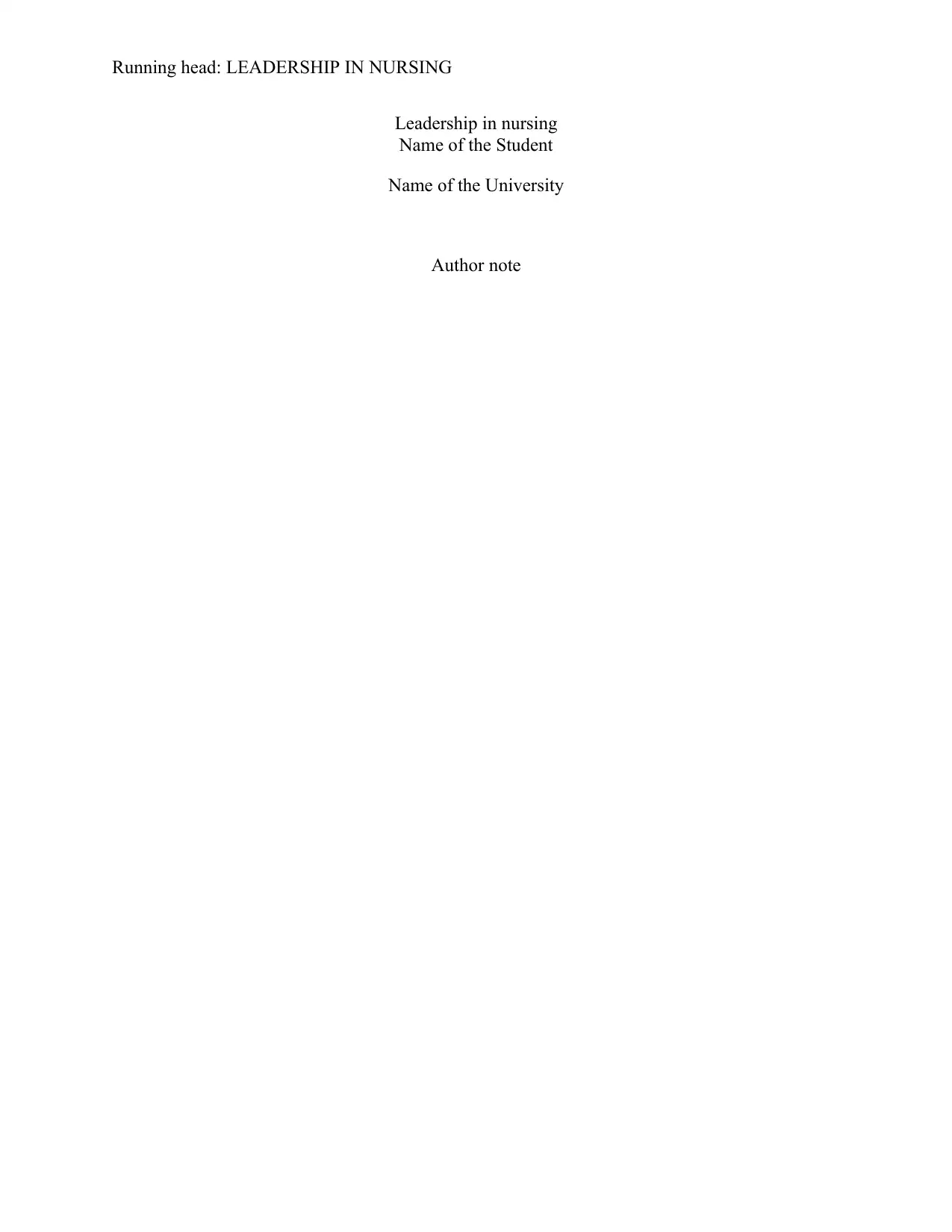
Running head: LEADERSHIP IN NURSING
Leadership in nursing
Name of the Student
Name of the University
Author note
Leadership in nursing
Name of the Student
Name of the University
Author note
Paraphrase This Document
Need a fresh take? Get an instant paraphrase of this document with our AI Paraphraser
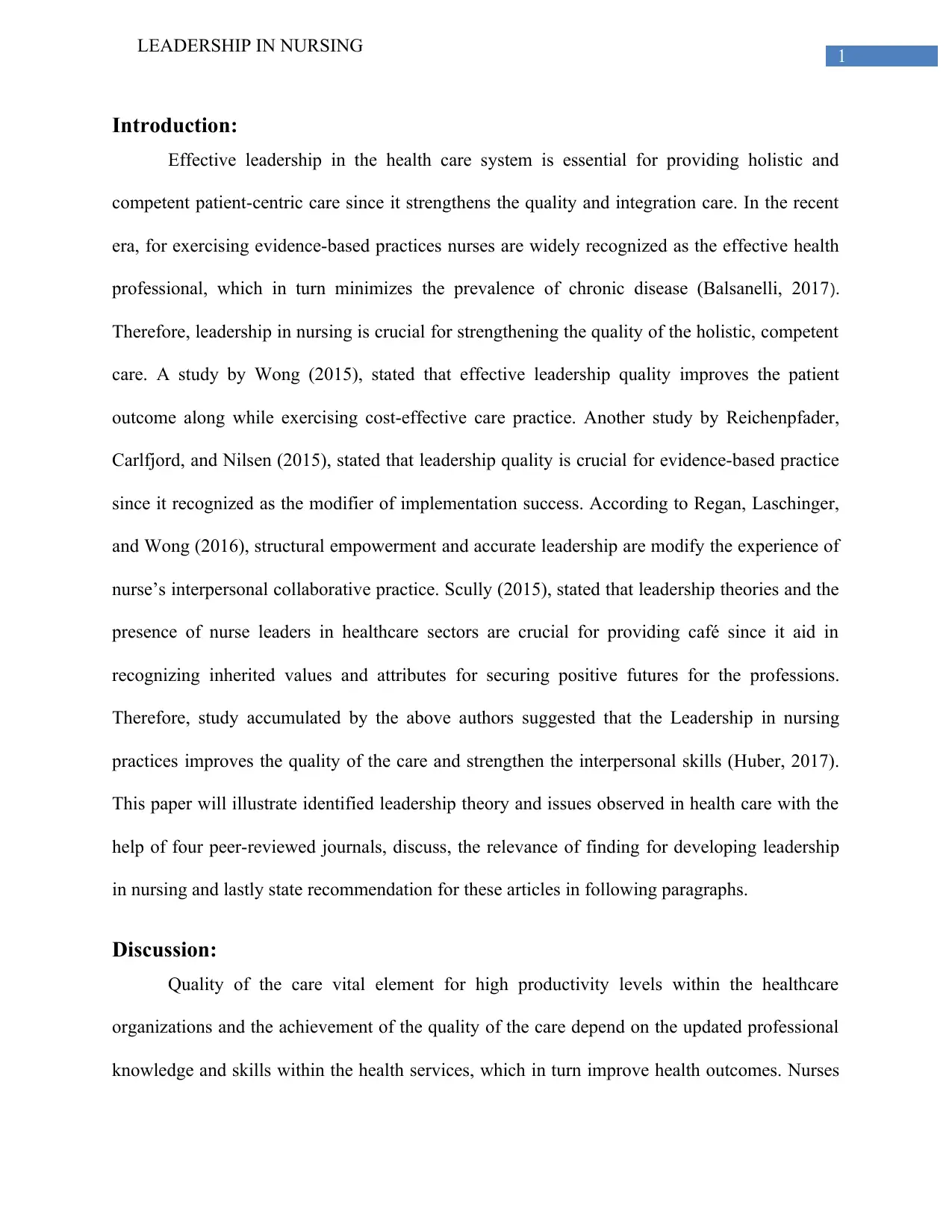
1
LEADERSHIP IN NURSING
Introduction:
Effective leadership in the health care system is essential for providing holistic and
competent patient-centric care since it strengthens the quality and integration care. In the recent
era, for exercising evidence-based practices nurses are widely recognized as the effective health
professional, which in turn minimizes the prevalence of chronic disease (Balsanelli, 2017).
Therefore, leadership in nursing is crucial for strengthening the quality of the holistic, competent
care. A study by Wong (2015), stated that effective leadership quality improves the patient
outcome along while exercising cost-effective care practice. Another study by Reichenpfader,
Carlfjord, and Nilsen (2015), stated that leadership quality is crucial for evidence-based practice
since it recognized as the modifier of implementation success. According to Regan, Laschinger,
and Wong (2016), structural empowerment and accurate leadership are modify the experience of
nurse’s interpersonal collaborative practice. Scully (2015), stated that leadership theories and the
presence of nurse leaders in healthcare sectors are crucial for providing café since it aid in
recognizing inherited values and attributes for securing positive futures for the professions.
Therefore, study accumulated by the above authors suggested that the Leadership in nursing
practices improves the quality of the care and strengthen the interpersonal skills (Huber, 2017).
This paper will illustrate identified leadership theory and issues observed in health care with the
help of four peer-reviewed journals, discuss, the relevance of finding for developing leadership
in nursing and lastly state recommendation for these articles in following paragraphs.
Discussion:
Quality of the care vital element for high productivity levels within the healthcare
organizations and the achievement of the quality of the care depend on the updated professional
knowledge and skills within the health services, which in turn improve health outcomes. Nurses
LEADERSHIP IN NURSING
Introduction:
Effective leadership in the health care system is essential for providing holistic and
competent patient-centric care since it strengthens the quality and integration care. In the recent
era, for exercising evidence-based practices nurses are widely recognized as the effective health
professional, which in turn minimizes the prevalence of chronic disease (Balsanelli, 2017).
Therefore, leadership in nursing is crucial for strengthening the quality of the holistic, competent
care. A study by Wong (2015), stated that effective leadership quality improves the patient
outcome along while exercising cost-effective care practice. Another study by Reichenpfader,
Carlfjord, and Nilsen (2015), stated that leadership quality is crucial for evidence-based practice
since it recognized as the modifier of implementation success. According to Regan, Laschinger,
and Wong (2016), structural empowerment and accurate leadership are modify the experience of
nurse’s interpersonal collaborative practice. Scully (2015), stated that leadership theories and the
presence of nurse leaders in healthcare sectors are crucial for providing café since it aid in
recognizing inherited values and attributes for securing positive futures for the professions.
Therefore, study accumulated by the above authors suggested that the Leadership in nursing
practices improves the quality of the care and strengthen the interpersonal skills (Huber, 2017).
This paper will illustrate identified leadership theory and issues observed in health care with the
help of four peer-reviewed journals, discuss, the relevance of finding for developing leadership
in nursing and lastly state recommendation for these articles in following paragraphs.
Discussion:
Quality of the care vital element for high productivity levels within the healthcare
organizations and the achievement of the quality of the care depend on the updated professional
knowledge and skills within the health services, which in turn improve health outcomes. Nurses

2
LEADERSHIP IN NURSING
are the primary stakeholders that help the healthcare setting for providing quality care to the
patient. In today’s changing and demanding healthcare environment nurse, leaders is one of the
greatest challenges faced by nursing professions.
A study by Scully (2015), suggested that nursing leadership are recognized as a vehicle to
improve health policies and nursing practices within the healthcare setting. Many accumulated
evidence failed to address the external factors that influence nursing leadership. In the paper, the
author identified that transformational leadership gained the popularity for being the center of
practices in nursing situations where nurse leaders are challenged to master situations in an ever-
changing environment; indeed many leading researchers advocate this approach. On the other
hand, transactional leadership involves both leaders and followers receiving something for their
effort (Makaroff et al., 2014). However, the author suggested the transactional leadership
depends on the development of culture, which allows the proactive supportive environment. The
nurse leaders possess the quality of vision, energy, self-discipline, and flexibility (Blair &
Jansen, 2015). The main issue is that often nurses failed to address the inherent values of nursing
while providing care to the patient, which further decrease the quality of care (Laschinger et al.,
2014). Therefore, the development of leadership is crucial for resolving this issue and secures a
future for the nursing profession.
The author, Reichenpfader, Carlfjord, and Nilsen (2015) stated that most of the
accumulate evidence highlighted the importance of leadership in the evidence-based practice of
nursing. However, the leadership varies depending on the domain they are working in. the author
suggested that most of the evidence accumulated from the literature indicate the essentiality of
transformational leadership with distinguishable training skills for future leaders in nursing
(Kearney-Nunnery, 2015). The study suggested that in order to gain leadership quality, the
LEADERSHIP IN NURSING
are the primary stakeholders that help the healthcare setting for providing quality care to the
patient. In today’s changing and demanding healthcare environment nurse, leaders is one of the
greatest challenges faced by nursing professions.
A study by Scully (2015), suggested that nursing leadership are recognized as a vehicle to
improve health policies and nursing practices within the healthcare setting. Many accumulated
evidence failed to address the external factors that influence nursing leadership. In the paper, the
author identified that transformational leadership gained the popularity for being the center of
practices in nursing situations where nurse leaders are challenged to master situations in an ever-
changing environment; indeed many leading researchers advocate this approach. On the other
hand, transactional leadership involves both leaders and followers receiving something for their
effort (Makaroff et al., 2014). However, the author suggested the transactional leadership
depends on the development of culture, which allows the proactive supportive environment. The
nurse leaders possess the quality of vision, energy, self-discipline, and flexibility (Blair &
Jansen, 2015). The main issue is that often nurses failed to address the inherent values of nursing
while providing care to the patient, which further decrease the quality of care (Laschinger et al.,
2014). Therefore, the development of leadership is crucial for resolving this issue and secures a
future for the nursing profession.
The author, Reichenpfader, Carlfjord, and Nilsen (2015) stated that most of the
accumulate evidence highlighted the importance of leadership in the evidence-based practice of
nursing. However, the leadership varies depending on the domain they are working in. the author
suggested that most of the evidence accumulated from the literature indicate the essentiality of
transformational leadership with distinguishable training skills for future leaders in nursing
(Kearney-Nunnery, 2015). The study suggested that in order to gain leadership quality, the
⊘ This is a preview!⊘
Do you want full access?
Subscribe today to unlock all pages.

Trusted by 1+ million students worldwide
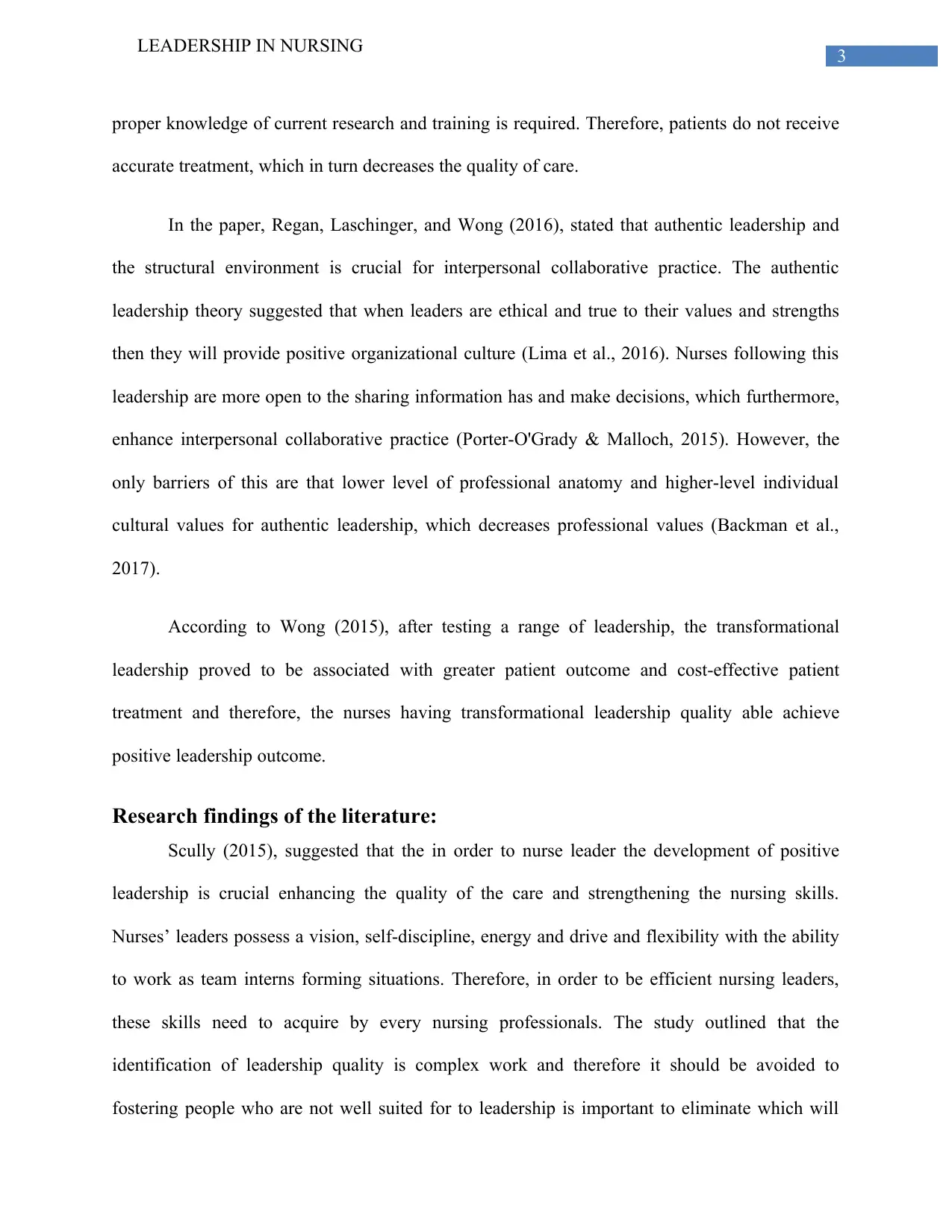
3
LEADERSHIP IN NURSING
proper knowledge of current research and training is required. Therefore, patients do not receive
accurate treatment, which in turn decreases the quality of care.
In the paper, Regan, Laschinger, and Wong (2016), stated that authentic leadership and
the structural environment is crucial for interpersonal collaborative practice. The authentic
leadership theory suggested that when leaders are ethical and true to their values and strengths
then they will provide positive organizational culture (Lima et al., 2016). Nurses following this
leadership are more open to the sharing information has and make decisions, which furthermore,
enhance interpersonal collaborative practice (Porter-O'Grady & Malloch, 2015). However, the
only barriers of this are that lower level of professional anatomy and higher-level individual
cultural values for authentic leadership, which decreases professional values (Backman et al.,
2017).
According to Wong (2015), after testing a range of leadership, the transformational
leadership proved to be associated with greater patient outcome and cost-effective patient
treatment and therefore, the nurses having transformational leadership quality able achieve
positive leadership outcome.
Research findings of the literature:
Scully (2015), suggested that the in order to nurse leader the development of positive
leadership is crucial enhancing the quality of the care and strengthening the nursing skills.
Nurses’ leaders possess a vision, self-discipline, energy and drive and flexibility with the ability
to work as team interns forming situations. Therefore, in order to be efficient nursing leaders,
these skills need to acquire by every nursing professionals. The study outlined that the
identification of leadership quality is complex work and therefore it should be avoided to
fostering people who are not well suited for to leadership is important to eliminate which will
LEADERSHIP IN NURSING
proper knowledge of current research and training is required. Therefore, patients do not receive
accurate treatment, which in turn decreases the quality of care.
In the paper, Regan, Laschinger, and Wong (2016), stated that authentic leadership and
the structural environment is crucial for interpersonal collaborative practice. The authentic
leadership theory suggested that when leaders are ethical and true to their values and strengths
then they will provide positive organizational culture (Lima et al., 2016). Nurses following this
leadership are more open to the sharing information has and make decisions, which furthermore,
enhance interpersonal collaborative practice (Porter-O'Grady & Malloch, 2015). However, the
only barriers of this are that lower level of professional anatomy and higher-level individual
cultural values for authentic leadership, which decreases professional values (Backman et al.,
2017).
According to Wong (2015), after testing a range of leadership, the transformational
leadership proved to be associated with greater patient outcome and cost-effective patient
treatment and therefore, the nurses having transformational leadership quality able achieve
positive leadership outcome.
Research findings of the literature:
Scully (2015), suggested that the in order to nurse leader the development of positive
leadership is crucial enhancing the quality of the care and strengthening the nursing skills.
Nurses’ leaders possess a vision, self-discipline, energy and drive and flexibility with the ability
to work as team interns forming situations. Therefore, in order to be efficient nursing leaders,
these skills need to acquire by every nursing professionals. The study outlined that the
identification of leadership quality is complex work and therefore it should be avoided to
fostering people who are not well suited for to leadership is important to eliminate which will
Paraphrase This Document
Need a fresh take? Get an instant paraphrase of this document with our AI Paraphraser
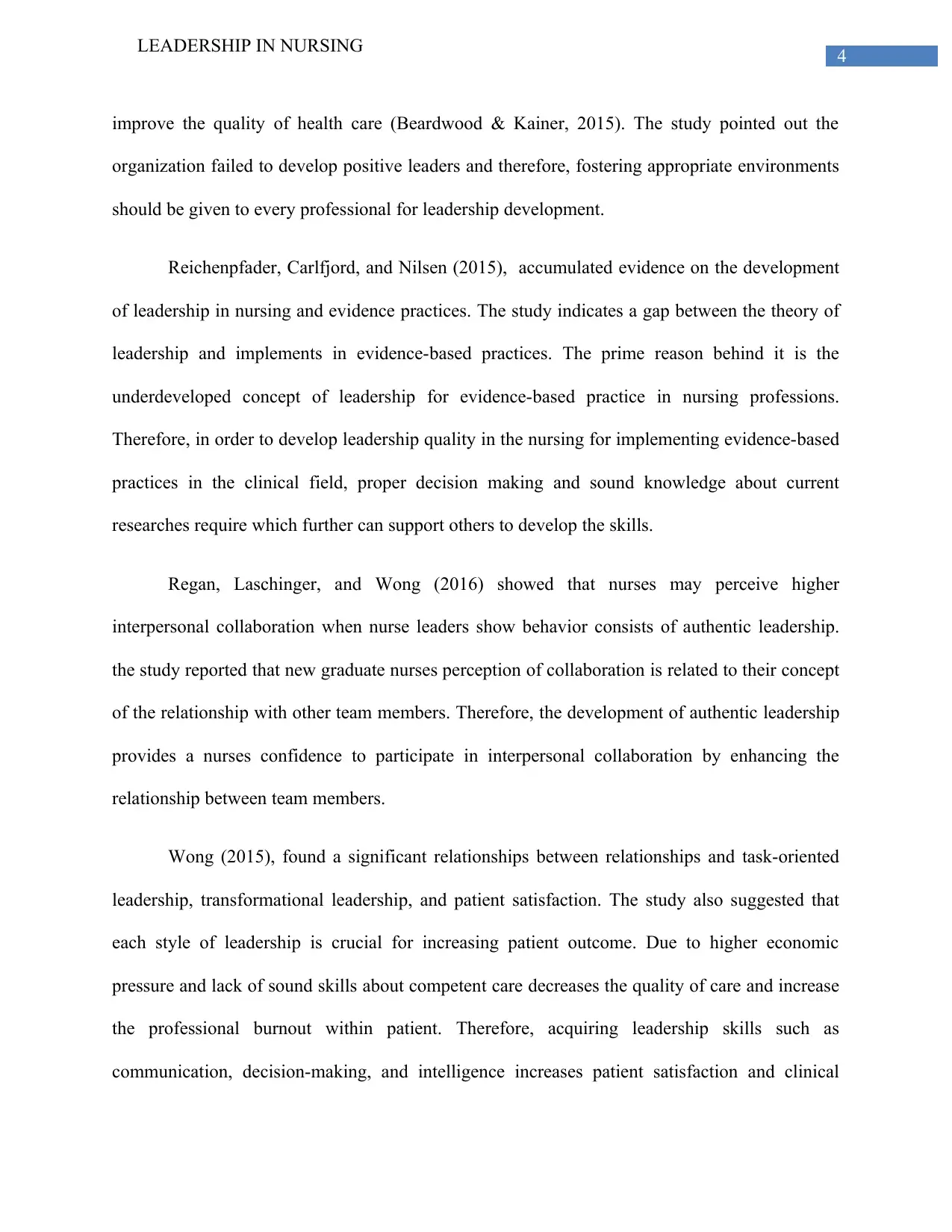
4
LEADERSHIP IN NURSING
improve the quality of health care (Beardwood & Kainer, 2015). The study pointed out the
organization failed to develop positive leaders and therefore, fostering appropriate environments
should be given to every professional for leadership development.
Reichenpfader, Carlfjord, and Nilsen (2015), accumulated evidence on the development
of leadership in nursing and evidence practices. The study indicates a gap between the theory of
leadership and implements in evidence-based practices. The prime reason behind it is the
underdeveloped concept of leadership for evidence-based practice in nursing professions.
Therefore, in order to develop leadership quality in the nursing for implementing evidence-based
practices in the clinical field, proper decision making and sound knowledge about current
researches require which further can support others to develop the skills.
Regan, Laschinger, and Wong (2016) showed that nurses may perceive higher
interpersonal collaboration when nurse leaders show behavior consists of authentic leadership.
the study reported that new graduate nurses perception of collaboration is related to their concept
of the relationship with other team members. Therefore, the development of authentic leadership
provides a nurses confidence to participate in interpersonal collaboration by enhancing the
relationship between team members.
Wong (2015), found a significant relationships between relationships and task-oriented
leadership, transformational leadership, and patient satisfaction. The study also suggested that
each style of leadership is crucial for increasing patient outcome. Due to higher economic
pressure and lack of sound skills about competent care decreases the quality of care and increase
the professional burnout within patient. Therefore, acquiring leadership skills such as
communication, decision-making, and intelligence increases patient satisfaction and clinical
LEADERSHIP IN NURSING
improve the quality of health care (Beardwood & Kainer, 2015). The study pointed out the
organization failed to develop positive leaders and therefore, fostering appropriate environments
should be given to every professional for leadership development.
Reichenpfader, Carlfjord, and Nilsen (2015), accumulated evidence on the development
of leadership in nursing and evidence practices. The study indicates a gap between the theory of
leadership and implements in evidence-based practices. The prime reason behind it is the
underdeveloped concept of leadership for evidence-based practice in nursing professions.
Therefore, in order to develop leadership quality in the nursing for implementing evidence-based
practices in the clinical field, proper decision making and sound knowledge about current
researches require which further can support others to develop the skills.
Regan, Laschinger, and Wong (2016) showed that nurses may perceive higher
interpersonal collaboration when nurse leaders show behavior consists of authentic leadership.
the study reported that new graduate nurses perception of collaboration is related to their concept
of the relationship with other team members. Therefore, the development of authentic leadership
provides a nurses confidence to participate in interpersonal collaboration by enhancing the
relationship between team members.
Wong (2015), found a significant relationships between relationships and task-oriented
leadership, transformational leadership, and patient satisfaction. The study also suggested that
each style of leadership is crucial for increasing patient outcome. Due to higher economic
pressure and lack of sound skills about competent care decreases the quality of care and increase
the professional burnout within patient. Therefore, acquiring leadership skills such as
communication, decision-making, and intelligence increases patient satisfaction and clinical
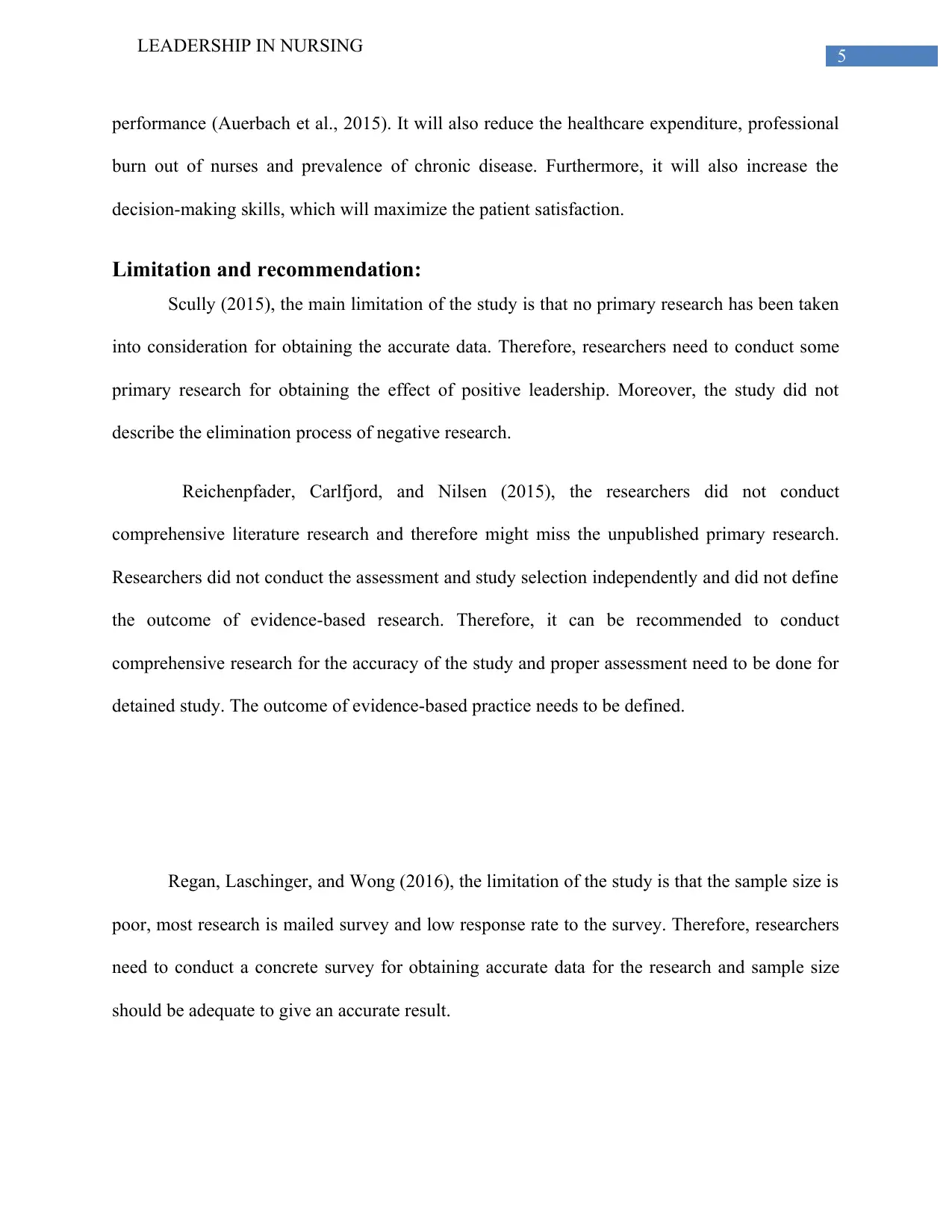
5
LEADERSHIP IN NURSING
performance (Auerbach et al., 2015). It will also reduce the healthcare expenditure, professional
burn out of nurses and prevalence of chronic disease. Furthermore, it will also increase the
decision-making skills, which will maximize the patient satisfaction.
Limitation and recommendation:
Scully (2015), the main limitation of the study is that no primary research has been taken
into consideration for obtaining the accurate data. Therefore, researchers need to conduct some
primary research for obtaining the effect of positive leadership. Moreover, the study did not
describe the elimination process of negative research.
Reichenpfader, Carlfjord, and Nilsen (2015), the researchers did not conduct
comprehensive literature research and therefore might miss the unpublished primary research.
Researchers did not conduct the assessment and study selection independently and did not define
the outcome of evidence-based research. Therefore, it can be recommended to conduct
comprehensive research for the accuracy of the study and proper assessment need to be done for
detained study. The outcome of evidence-based practice needs to be defined.
Regan, Laschinger, and Wong (2016), the limitation of the study is that the sample size is
poor, most research is mailed survey and low response rate to the survey. Therefore, researchers
need to conduct a concrete survey for obtaining accurate data for the research and sample size
should be adequate to give an accurate result.
LEADERSHIP IN NURSING
performance (Auerbach et al., 2015). It will also reduce the healthcare expenditure, professional
burn out of nurses and prevalence of chronic disease. Furthermore, it will also increase the
decision-making skills, which will maximize the patient satisfaction.
Limitation and recommendation:
Scully (2015), the main limitation of the study is that no primary research has been taken
into consideration for obtaining the accurate data. Therefore, researchers need to conduct some
primary research for obtaining the effect of positive leadership. Moreover, the study did not
describe the elimination process of negative research.
Reichenpfader, Carlfjord, and Nilsen (2015), the researchers did not conduct
comprehensive literature research and therefore might miss the unpublished primary research.
Researchers did not conduct the assessment and study selection independently and did not define
the outcome of evidence-based research. Therefore, it can be recommended to conduct
comprehensive research for the accuracy of the study and proper assessment need to be done for
detained study. The outcome of evidence-based practice needs to be defined.
Regan, Laschinger, and Wong (2016), the limitation of the study is that the sample size is
poor, most research is mailed survey and low response rate to the survey. Therefore, researchers
need to conduct a concrete survey for obtaining accurate data for the research and sample size
should be adequate to give an accurate result.
⊘ This is a preview!⊘
Do you want full access?
Subscribe today to unlock all pages.

Trusted by 1+ million students worldwide
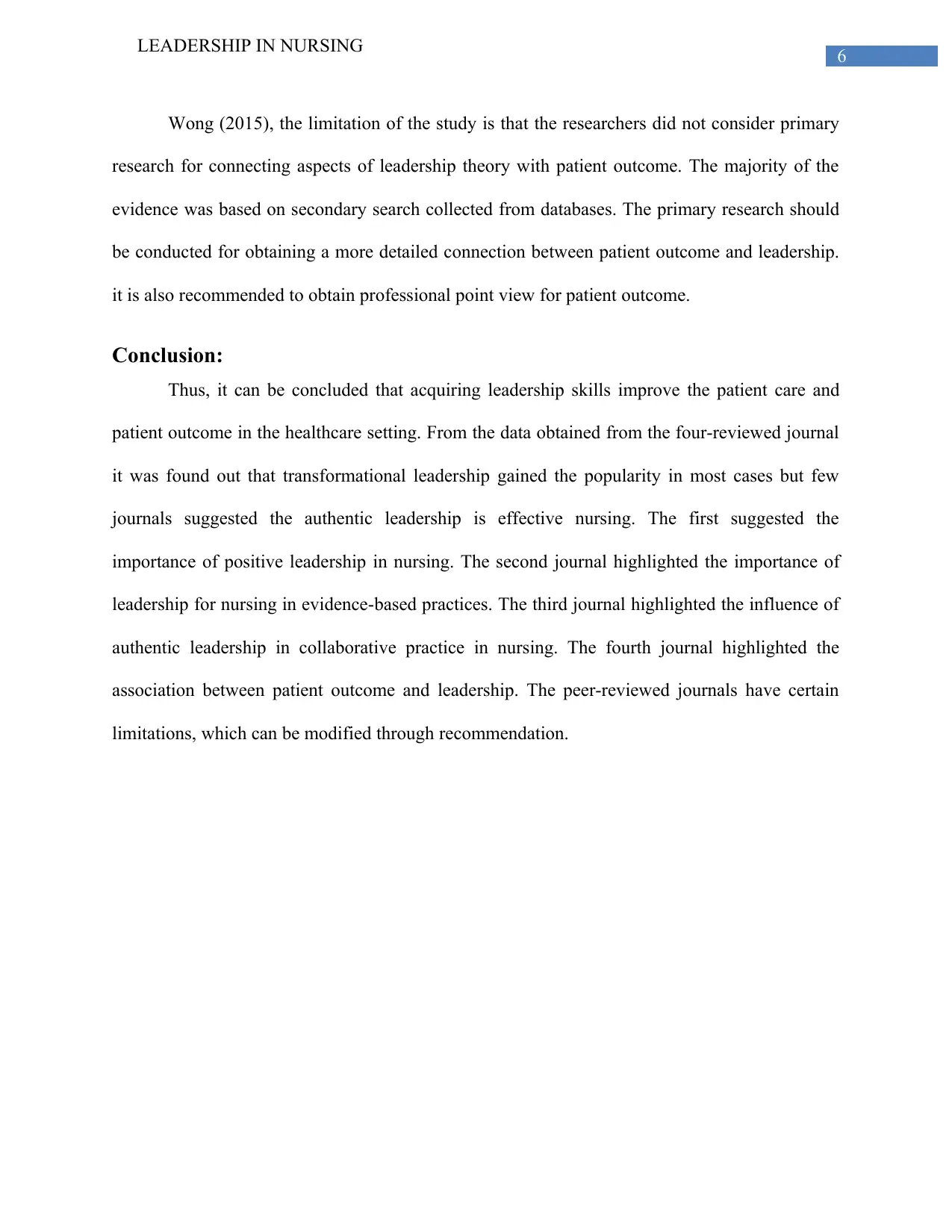
6
LEADERSHIP IN NURSING
Wong (2015), the limitation of the study is that the researchers did not consider primary
research for connecting aspects of leadership theory with patient outcome. The majority of the
evidence was based on secondary search collected from databases. The primary research should
be conducted for obtaining a more detailed connection between patient outcome and leadership.
it is also recommended to obtain professional point view for patient outcome.
Conclusion:
Thus, it can be concluded that acquiring leadership skills improve the patient care and
patient outcome in the healthcare setting. From the data obtained from the four-reviewed journal
it was found out that transformational leadership gained the popularity in most cases but few
journals suggested the authentic leadership is effective nursing. The first suggested the
importance of positive leadership in nursing. The second journal highlighted the importance of
leadership for nursing in evidence-based practices. The third journal highlighted the influence of
authentic leadership in collaborative practice in nursing. The fourth journal highlighted the
association between patient outcome and leadership. The peer-reviewed journals have certain
limitations, which can be modified through recommendation.
LEADERSHIP IN NURSING
Wong (2015), the limitation of the study is that the researchers did not consider primary
research for connecting aspects of leadership theory with patient outcome. The majority of the
evidence was based on secondary search collected from databases. The primary research should
be conducted for obtaining a more detailed connection between patient outcome and leadership.
it is also recommended to obtain professional point view for patient outcome.
Conclusion:
Thus, it can be concluded that acquiring leadership skills improve the patient care and
patient outcome in the healthcare setting. From the data obtained from the four-reviewed journal
it was found out that transformational leadership gained the popularity in most cases but few
journals suggested the authentic leadership is effective nursing. The first suggested the
importance of positive leadership in nursing. The second journal highlighted the importance of
leadership for nursing in evidence-based practices. The third journal highlighted the influence of
authentic leadership in collaborative practice in nursing. The fourth journal highlighted the
association between patient outcome and leadership. The peer-reviewed journals have certain
limitations, which can be modified through recommendation.
Paraphrase This Document
Need a fresh take? Get an instant paraphrase of this document with our AI Paraphraser

7
LEADERSHIP IN NURSING
references :
Auerbach, D. I., Martsolf, G. R., Pearson, M. L., Taylor, E. A., Zaydman, M., Muchow, A. N., ...
& Lee, Y. (2015). The DNP by 2015: A study of the institutional, political, and
professional issues that facilitate or impede establishing a post-baccalaureate doctor of
nursing practice program. Rand health quarterly, 5(1).
Backman, A., Sjögren, K., Lindkvist, M., Lövheim, H., & Edvardsson, D. (2017). Characteristics
of highly rated leadership in nursing homes using item response theory. Journal of
advanced nursing, 73(12), 2903-2913.
Balsanelli, A. P. (2017). Leadership in nursing: Challenges and possibilities. Acta Paulista de
Enfermagem, 30(1), 3-4.
Beardwood, B. A., & Kainer, J. M. (2015). Exploring risk in professional nursing practice: an
analysis of work refusal and professional risk. Nursing inquiry, 22(1), 50-63.
Blair, K. A., & Jansen, M. P. (Eds.). (2015). Advanced practice nursing: Core concepts for
professional role development. Springer Publishing Company.
Huber, D. (2017). Leadership and Nursing Care Management-E-Book. Elsevier Health Sciences.
Kearney-Nunnery, R. (2015). Advancing Your Career Concepts in Professional Nursing. FA
Davis.
Laschinger, H. K. S., Nosko, A., Wilk, P., & Finegan, J. (2014). Effects of unit empowerment
and perceived support for professional nursing practice on unit effectiveness and
LEADERSHIP IN NURSING
references :
Auerbach, D. I., Martsolf, G. R., Pearson, M. L., Taylor, E. A., Zaydman, M., Muchow, A. N., ...
& Lee, Y. (2015). The DNP by 2015: A study of the institutional, political, and
professional issues that facilitate or impede establishing a post-baccalaureate doctor of
nursing practice program. Rand health quarterly, 5(1).
Backman, A., Sjögren, K., Lindkvist, M., Lövheim, H., & Edvardsson, D. (2017). Characteristics
of highly rated leadership in nursing homes using item response theory. Journal of
advanced nursing, 73(12), 2903-2913.
Balsanelli, A. P. (2017). Leadership in nursing: Challenges and possibilities. Acta Paulista de
Enfermagem, 30(1), 3-4.
Beardwood, B. A., & Kainer, J. M. (2015). Exploring risk in professional nursing practice: an
analysis of work refusal and professional risk. Nursing inquiry, 22(1), 50-63.
Blair, K. A., & Jansen, M. P. (Eds.). (2015). Advanced practice nursing: Core concepts for
professional role development. Springer Publishing Company.
Huber, D. (2017). Leadership and Nursing Care Management-E-Book. Elsevier Health Sciences.
Kearney-Nunnery, R. (2015). Advancing Your Career Concepts in Professional Nursing. FA
Davis.
Laschinger, H. K. S., Nosko, A., Wilk, P., & Finegan, J. (2014). Effects of unit empowerment
and perceived support for professional nursing practice on unit effectiveness and
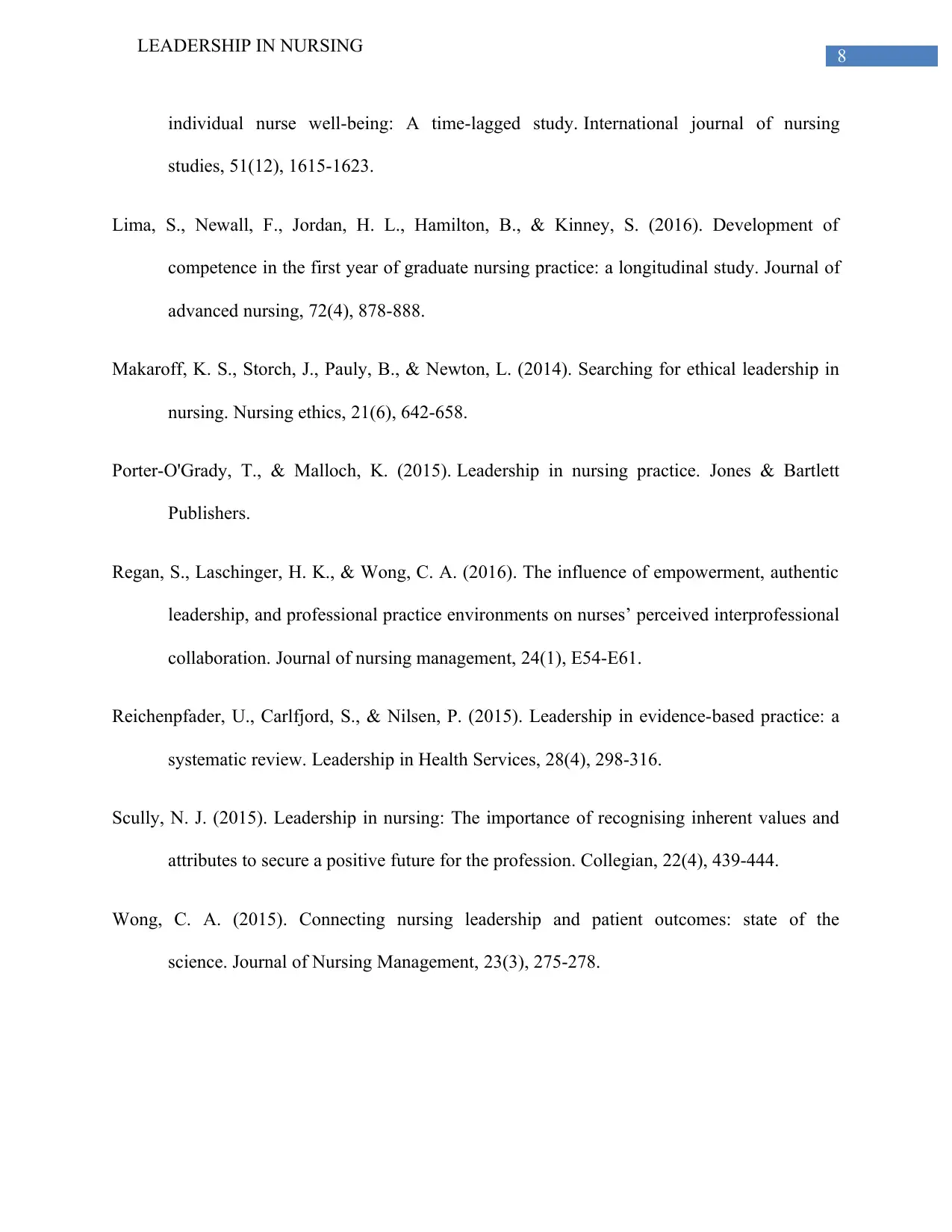
8
LEADERSHIP IN NURSING
individual nurse well-being: A time-lagged study. International journal of nursing
studies, 51(12), 1615-1623.
Lima, S., Newall, F., Jordan, H. L., Hamilton, B., & Kinney, S. (2016). Development of
competence in the first year of graduate nursing practice: a longitudinal study. Journal of
advanced nursing, 72(4), 878-888.
Makaroff, K. S., Storch, J., Pauly, B., & Newton, L. (2014). Searching for ethical leadership in
nursing. Nursing ethics, 21(6), 642-658.
Porter-O'Grady, T., & Malloch, K. (2015). Leadership in nursing practice. Jones & Bartlett
Publishers.
Regan, S., Laschinger, H. K., & Wong, C. A. (2016). The influence of empowerment, authentic
leadership, and professional practice environments on nurses’ perceived interprofessional
collaboration. Journal of nursing management, 24(1), E54-E61.
Reichenpfader, U., Carlfjord, S., & Nilsen, P. (2015). Leadership in evidence-based practice: a
systematic review. Leadership in Health Services, 28(4), 298-316.
Scully, N. J. (2015). Leadership in nursing: The importance of recognising inherent values and
attributes to secure a positive future for the profession. Collegian, 22(4), 439-444.
Wong, C. A. (2015). Connecting nursing leadership and patient outcomes: state of the
science. Journal of Nursing Management, 23(3), 275-278.
LEADERSHIP IN NURSING
individual nurse well-being: A time-lagged study. International journal of nursing
studies, 51(12), 1615-1623.
Lima, S., Newall, F., Jordan, H. L., Hamilton, B., & Kinney, S. (2016). Development of
competence in the first year of graduate nursing practice: a longitudinal study. Journal of
advanced nursing, 72(4), 878-888.
Makaroff, K. S., Storch, J., Pauly, B., & Newton, L. (2014). Searching for ethical leadership in
nursing. Nursing ethics, 21(6), 642-658.
Porter-O'Grady, T., & Malloch, K. (2015). Leadership in nursing practice. Jones & Bartlett
Publishers.
Regan, S., Laschinger, H. K., & Wong, C. A. (2016). The influence of empowerment, authentic
leadership, and professional practice environments on nurses’ perceived interprofessional
collaboration. Journal of nursing management, 24(1), E54-E61.
Reichenpfader, U., Carlfjord, S., & Nilsen, P. (2015). Leadership in evidence-based practice: a
systematic review. Leadership in Health Services, 28(4), 298-316.
Scully, N. J. (2015). Leadership in nursing: The importance of recognising inherent values and
attributes to secure a positive future for the profession. Collegian, 22(4), 439-444.
Wong, C. A. (2015). Connecting nursing leadership and patient outcomes: state of the
science. Journal of Nursing Management, 23(3), 275-278.
⊘ This is a preview!⊘
Do you want full access?
Subscribe today to unlock all pages.

Trusted by 1+ million students worldwide

9
LEADERSHIP IN NURSING
LEADERSHIP IN NURSING
1 out of 10
Related Documents
Your All-in-One AI-Powered Toolkit for Academic Success.
+13062052269
info@desklib.com
Available 24*7 on WhatsApp / Email
![[object Object]](/_next/static/media/star-bottom.7253800d.svg)
Unlock your academic potential
Copyright © 2020–2025 A2Z Services. All Rights Reserved. Developed and managed by ZUCOL.





